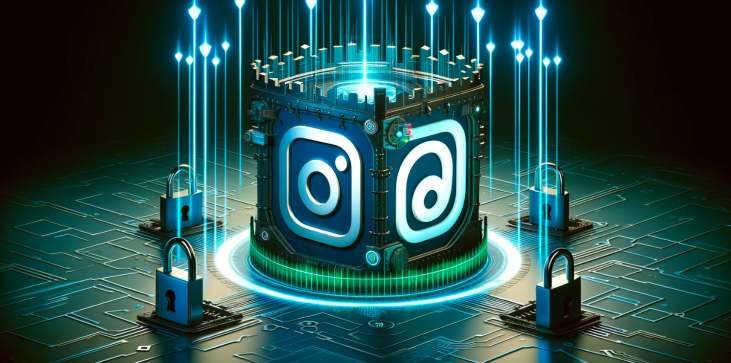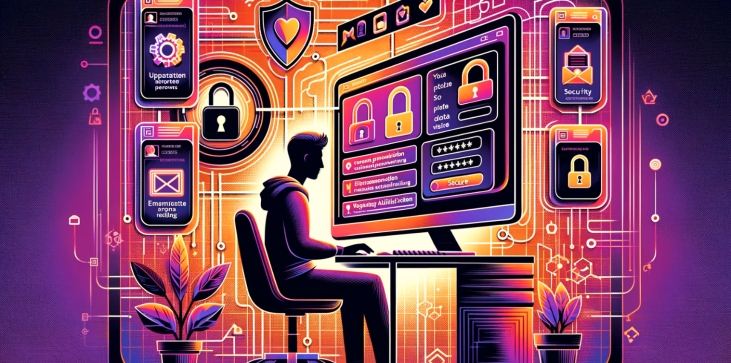
In today's digital age, social media platforms like Instagram have become integral to our daily lives. They serve as hubs for personal expression, business branding, and social interaction. Consequently, the security of these platforms is paramount. I know firsthand how distressing it can be to have your personal space invaded, and when it comes to Instagram, the threat of being hacked is a looming concern for many users. Protecting your Instagram account isn't just about safeguarding your personal photos and messages; it's about maintaining your online identity and privacy. The repercussions of an Instagram account falling victim to cybercriminals are severe. They range from minor inconveniences to major breaches of personal and financial information. Given the platform’s popularity, it is a lucrative target for malicious activities. Therefore, understanding the significance of securing one's Instagram account cannot be overstressed. For me, the realization of how critical this issue was hit home when a close friend experienced an account breach. Witnessing the fallout from their privacy being compromised underscored the importance of taking proactive measures. This incident was the catalyst that drove me to delve deep into the realm of cybersecurity on social media, particularly for Instagram, and I am eager to share these crucial steps to help others avoid such distressing experiences.
The question of how Instagram accounts become compromised is complex. Hackers are constantly finding new ways to infiltrate accounts, but there are common tactics that they frequently use. Understanding these can be the first line of defense in protecting your account.
One common method is through the use of brute force attacks. This involves using software that systematically tries a plethora of possible passwords until the correct one is found. Another tactic is phishing, where hackers pose as a legitimate entity to trick users into giving up their login details. Additionally, malware and spyware can also be employed to surreptitiously gather a user's information.
Then there are the more sophisticated methods, such as exploiting the software's vulnerabilities and social engineering where hackers manipulate users into compromising their own security. It's also worth noting that once one account is hacked, it becomes easier for cybercriminals to access other accounts, especially if the user recycles passwords.
Lastly, in my experience, many users unwittingly make their accounts vulnerable by sharing too much personal information online or by using insecure networks. It's crucial to be aware of these risks and take the necessary precautions to minimize them.
Recognizing that your Instagram account may have been hacked is the first step to regaining control. There are several tell-tale signs that can alert you to unauthorized activity. For instance, if you notice posts, messages, or comments that you did not create, this is a clear indicator of a breach.
Another red flag is receiving a notification from Instagram about a login attempt from an unfamiliar location or device. If your friends report receiving requests or messages from your account that you did not send, this is also a cause for concern. Moreover, finding that personal account information such as your email address or phone number has been altered without your knowledge is a serious sign of being hacked.
Should you be unable to log in with your usual credentials, it may be that a hacker has already changed your login details. Frequent account disconnections or notifications about account access can also be symptomatic of a security issue. It is essential to act swiftly if you notice any of these signs to prevent further damage.
One of the simplest yet most effective steps in safeguarding your Instagram account is creating a robust and distinctive password. A strong password is like a fortified gate that makes it challenging for intruders to gain entry. It should be a complex combination of letters, numbers, and special characters that is difficult to guess.
To craft a unique password, avoid using easily accessible personal information such as your name, birthday, or common words. Instead, opt for a password that is a random assortment of characters and has a significant length – I recommend at least 12 characters. Utilizing a password manager can assist in generating and storing these intricate passwords securely.
Changing your password regularly is another key aspect of maintaining account security. This practice ensures that even if your password is somehow compromised, the window of opportunity for a hacker to exploit it is limited. Make sure that your Instagram password is distinct from those you use for other accounts, as this reduces the risk if one of your other accounts is breached.
Two-factor authentication (2FA) adds an extra layer of defense to your account security, and enabling it is a critical step in preventing unauthorized access. This feature requires an additional piece of information beyond your password to log in, typically a code sent to your mobile device or generated by an authentication app.
Activating 2FA on Instagram is straightforward. You can find the option within the security settings of the app. Once enabled, even if someone obtains your password, they would still need access to your second authentication factor to hack into your account, making it significantly more challenging for them to do so.
I consider 2FA to be an essential tool in my personal cybersecurity arsenal. It's a simple, yet highly effective way to ensure that you're the only person who can access your account, even if your password becomes known to someone else. It's worth noting that while 2FA is a powerful security measure, it's not infallible, so it should be part of a broader security strategy.
The internet is rife with deceptive links and phishing attempts, and being cautious of these is crucial in protecting your Instagram account. Phishing scams often come in the form of emails or direct messages that appear to be from Instagram or another trusted entity, urging you to click on a link and enter your login details.
To avoid falling victim to these schemes, always verify the legitimacy of messages and emails before interacting with them. Look out for odd email addresses, spelling mistakes, and unsolicited requests for personal information. A good rule of thumb is to never input your Instagram login details on any page that you've arrived at through a link. Instead, manually navigate to the official Instagram website or use the app.
Additionally, be wary of third-party apps that request access to your Instagram account. These could be fronts for collecting login credentials. Always research and verify the authenticity of any app before granting it permissions. By maintaining a healthy level of skepticism and vigilance when it comes to suspicious links and messages, you can greatly reduce the risk of your account being compromised.

Keeping your Instagram app and associated devices up-to-date is an often-overlooked yet vital step in securing your account. Updates frequently include patches for security vulnerabilities that, if left unaddressed, could be exploited by hackers.
Make it a habit to install updates for the Instagram app as soon as they become available. The same goes for your smartphone's operating system. Cybercriminals are quick to take advantage of known vulnerabilities, and running outdated software is akin to leaving your front door unlocked.
Moreover, be mindful of the sources from which you download the Instagram app. Always use the official app store for your device, as unofficial sources may distribute versions of the app that have been tampered with to compromise your security. By ensuring that both your app and your devices are equipped with the latest security features, you create a more challenging environment for potential hackers.
Vigilance in monitoring your Instagram account activity is a proactive defense against hacking. Regularly review your account for any unusual activity, such as unexpected posts, comments, or messages. Instagram provides tools to check login activity, which can help you spot unauthorized access.
If you detect any suspicious behavior, take immediate action. Change your password and report the activity to Instagram. The platform has mechanisms in place to assist users in regaining control of their accounts and preventing further unauthorized access.
It's also beneficial to educate yourself on the latest scams and security threats. This knowledge allows you to recognize potential dangers and respond accordingly. Remember, the sooner you identify and react to suspicious activity, the less damage a hacker is likely to inflict.
Discovering that your Instagram account has been hacked can be a harrowing experience, but it's important to remain calm and act quickly. The first step is to attempt to reset your password. This can often be done through the login screen by following the 'Forgot password?' link.
If the hacker has changed your email and phone number, you will need to seek assistance directly from Instagram. The app offers a support flow for compromised accounts, which you can access by following the instructions on the login page. Be prepared to verify your identity, which may involve providing a photo ID.
Once you've regained access to your account, review your security settings, revoke access to any suspicious third-party apps, and inform your followers that your account was compromised. This will help prevent the spread of any malicious content that may have been posted during the breach.
In conclusion, the security of your Instagram account should never be taken lightly. By following the steps I've outlined – creating a strong password, enabling two-factor authentication, being vigilant against phishing, keeping your app and devices updated, and monitoring your account activity – you can significantly reduce the likelihood of being hacked.
Should the worst happen, and you find your account compromised, knowing the correct actions to take can make the difference between a quick recovery and a prolonged ordeal. Remember, cybersecurity is not a one-time task but an ongoing practice.
I hope that by sharing these insights, I've empowered you to take control of your Instagram account's security. It's worth investing the time and effort to protect your digital presence, as the peace of mind that comes with enhanced security is invaluable. Stay safe, stay secure, and keep enjoying the vibrant world of Instagram with confidence.
Some signs that your Instagram account may have been hacked include unexpected changes to your profile, such as a new display name or bio; unfamiliar posts or stories on your feed; receiving notifications for logins from unknown devices or locations; and difficulty accessing your own account due to password reset requests you did not initiate. If you notice any of these signs, take immediate action to secure your account.
To safeguard your Instagram account against hacking attempts, follow these essential steps: (1) use strong and unique passwords, ideally incorporating a mix of letters, numbers, and special characters; (2) enable two-factor authentication to add an extra layer of security; (3) be cautious when clicking links in direct messages or comments, especially those prompting you to enter your login credentials; (4) regularly review authorized applications with access to your account, revoking permissions for any suspicious apps; and (5) stay informed about phishing scams targeting Instagram users by double-checking URLs before entering sensitive information.
Yes, there is still hope for regaining control over your hacked Instagram account. First, try resetting your password using the associated email address or phone number linked to your account. If this method fails or becomes unavailable due to recent changes made by the hacker, contact Instagram support directly through their Help Center, providing detailed information regarding the issue. Be prepared to verify your identity via various means, including backup emails, phone numbers, or government-issued IDs. Remember to act swiftly, as timely response increases the likelihood of successfully restoring your compromised account.